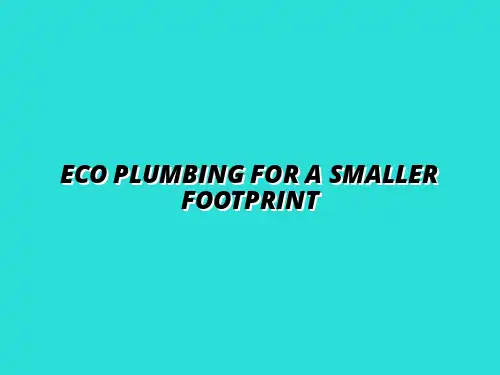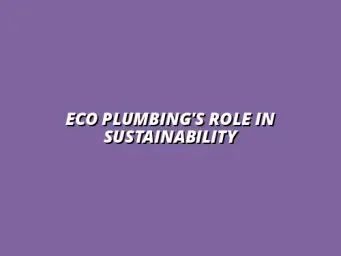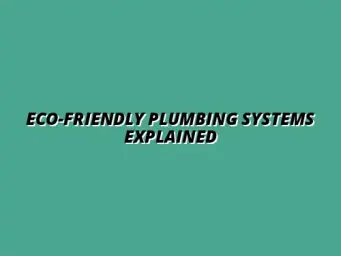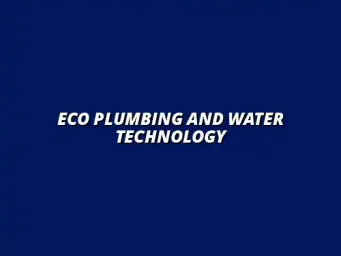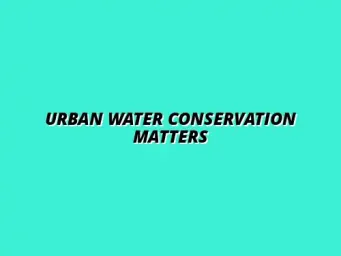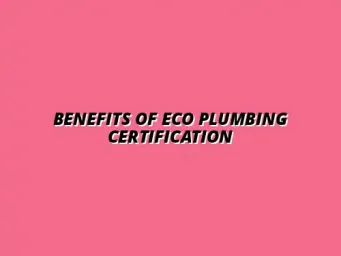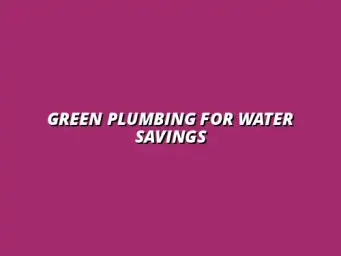Understanding Eco Plumbing and Its Importance in Reducing Carbon Footprint
Eco plumbing is a growing trend that focuses on using sustainable practices in plumbing systems to minimize environmental impact. It aims to reduce water and energy consumption while improving the quality of our water supply. By understanding eco plumbing, we can take significant steps toward reducing our carbon footprint and promoting a healthier planet!
Defining Eco Plumbing
At its core, eco plumbing refers to plumbing practices designed to be environmentally friendly. This includes the use of materials and techniques that reduce water waste, enhance energy efficiency, and promote sustainability. By incorporating eco-friendly solutions, we can create a plumbing system that not only benefits us but also protects our precious natural resources. Learn more about the benefits of eco-friendly plumbing for homeowners.
Overview of Eco Plumbing Practices
Eco plumbing encompasses various practices aimed at conserving water and energy. Some of the key practices include:
- Using low-flow fixtures to reduce water usage.
- Implementing rainwater harvesting systems.
- Recycling greywater for non-potable uses.
- Utilizing renewable energy sources for heating.
These practices help create a plumbing system that operates efficiently while being gentle on the environment. By adopting these methods, we can significantly lower our resource consumption!
Key Components of Eco Plumbing Systems
There are several essential components that make up an eco plumbing system. These include
- Low-flow fixtures: These faucets and showerheads reduce water usage without sacrificing performance.
- Water-efficient appliances: Dishwashers and washing machines designed to use less water and energy.
- Rainwater harvesting systems: Collecting and storing rainwater for irrigation and non-potable uses. See how water-efficient irrigation can benefit you.
- Greywater recycling systems: Treatment and reuse of water from sinks, showers, and washing machines.
By integrating these components, an eco plumbing system can effectively minimize waste and enhance sustainability. As we make these changes, we create a healthier environment for ourselves and future generations!
The Role of Eco Plumbing in Environmental Sustainability
Eco plumbing plays a significant role in promoting environmental sustainability. By making small changes to our plumbing systems, we can have a big impact on our environment. It’s essential to understand how these systems contribute to a greener future!
How Eco Plumbing Contributes to Carbon Footprint Reduction
One of the primary goals of eco plumbing is to reduce our carbon footprint. It achieves this through:
- Efficient water usage: Less water means less energy is needed to pump, heat, and treat water.
- Use of renewable energy: Solar water heaters and other renewable options help cut down on fossil fuel use.
- Minimized waste: Recycling and reusing water decreases the overall demand for fresh water resources.
By implementing these techniques, we can significantly lower greenhouse gas emissions. This aligns perfectly with our goals of being responsible stewards of the planet!
Aligning Eco Plumbing with Global Sustainability Goals
Eco plumbing is not just about individual practices; it's about contributing to global sustainability goals. These goals aim to create a more sustainable world through:
- Access to clean water and sanitation.
- Responsible consumption and production patterns.
- Climate action initiatives that cut carbon emissions.
When we align eco plumbing practices with these global goals, we support a vision of sustainability that benefits not just us, but the entire planet. Every small effort counts!
Common Eco Plumbing Techniques That Minimize Carbon Emissions
There are several eco plumbing techniques that can effectively minimize carbon emissions. By employing these methods, we can create a more sustainable plumbing system. Let’s explore some of the most common techniques!
Utilization of Low-Flow Fixtures
Low-flow fixtures are an essential part of eco plumbing. They help reduce the amount of water we use without sacrificing comfort. Regular inspections can prevent costly plumbing leaks. Check out these maintenance tips to keep your kitchen plumbing in top shape. Common low-flow options include:
- Low-flow showerheads that maintain water pressure while reducing usage.
- Low-flow faucets that control the flow rate.
- Dual-flush toilets that allow for different flush volumes based on need.
Switching to these fixtures can lead to substantial water savings, which translates to lower energy costs as well!
Benefits of Rainwater Harvesting Systems
Rainwater harvesting systems collect and store rainwater for various uses. This technique offers numerous benefits, including:
- Reduction in reliance on municipal water supply.
- Lower water bills through reduced consumption.
- Effective irrigation solutions without using treated water.
By harnessing this natural resource, we can significantly reduce our environmental impact while also saving money!
Advantages of Greywater Recycling Solutions
Greywater recycling systems treat and reuse water from sinks, showers, and washing machines. This approach has several advantages, such as:
- Conserving fresh water for drinking and cooking.
- Reducing wastewater treatment needs.
- Lowering water bills by reusing water for irrigation and flushing toilets.
Implementing greywater recycling can make a big difference in our overall water consumption and carbon footprint!
Evaluating the Impact of Eco Plumbing on Energy Efficiency
Energy efficiency is another critical aspect of eco plumbing. By focusing on energy-saving solutions, we can greatly impact both our bills and the environment. Scheduling regular water heater inspections is crucial for efficiency and safety. Learn more about scheduling regular water heater inspections. Here’s how eco plumbing can help!
How Insulation and Efficient Heating Can Cut Carbon Emissions
Proper insulation and energy-efficient heating systems play a vital role in eco plumbing. These elements can:
- Minimize heat loss in pipes and hot water systems.
- Reduce energy consumption for heating water.
- Lower greenhouse gas emissions associated with energy use.
By ensuring our plumbing systems are well-insulated and efficient, we can make significant strides toward reducing our carbon footprint!
The Role of Renewable Energy in Eco Plumbing Systems
Integrating renewable energy sources into plumbing systems can further enhance energy efficiency. This includes:
- Solar water heaters that use sunlight to heat water.
- Heat pumps that transfer heat from the air or ground.
- Biomass energy systems that utilize organic materials for heating.
By adopting renewable energy solutions, we can create a more sustainable plumbing system that reduces our reliance on fossil fuels!
Financial Considerations of Investing in Eco Plumbing Solutions
Investing in eco plumbing solutions can lead to significant financial advantages. While the initial costs may seem high, the long-term savings can be substantial. Discover how eco-plumbing saves money over time. Let’s take a closer look at these financial considerations!
Long-Term Cost Savings from Eco Plumbing
Though eco plumbing solutions may require upfront investments, they can lead to cost savings in various ways, such as:
- Lower water bills due to reduced consumption.
- Decreased energy bills from using efficient systems.
- Longer lifespan of plumbing fixtures due to their durability.
By making these investments, we not only benefit our wallets but also contribute to a healthier planet!
Government Incentives and Rebates for Eco-Friendly Plumbing
Many governments offer incentives and rebates for adopting eco plumbing solutions. These programs can help offset initial costs, making it easier to switch to sustainable practices. Some common incentives include:
- Tax credits for energy-efficient appliances.
- Subsidies for rainwater harvesting systems.
- Rebates for low-flow fixtures and other eco-friendly upgrades.
Taking advantage of these programs can significantly reduce the financial burden of transitioning to eco plumbing!
Addressing Common Misconceptions About Eco Plumbing
There are many misconceptions surrounding eco plumbing. It’s essential to clarify these myths to promote understanding and acceptance. Let’s address some of the most common misconceptions!
Myths vs. Reality: The Effectiveness of Eco Plumbing
Some people believe that eco plumbing solutions are less effective than traditional systems. In reality, eco plumbing can provide:
- Similar or improved performance through modern technology.
- Significant water and energy savings.
- A positive impact on the environment without sacrificing comfort.
By dispelling these myths, we encourage more people to adopt sustainable plumbing practices!
Understanding Initial Costs vs. Long-Term Benefits
Many individuals worry about the initial costs associated with eco plumbing. However, understanding the long-term benefits can help shift this perspective. The reality is:
- Initial investments lead to future savings on utility bills.
- Eco plumbing systems often have longer lifespans.
- They contribute to a healthier environment, benefiting us all.
Recognizing these advantages can motivate more individuals to invest in eco plumbing solutions!
Practical Steps to Implement Eco Plumbing in Your Home
Implementing eco plumbing in your home is a fantastic way to contribute to environmental sustainability and reduce your carbon footprint. To start this journey, it’s essential to assess your current plumbing system and identify areas where improvements can be made. By following a few simple steps, you can not only enhance the efficiency of your plumbing but also save money in the long run! For example, regular bathroom water heater checks are essential for preventing problems. Learn more about regular bathroom water heater checks.
Understanding your existing plumbing setup can be daunting, but don’t worry! I’ll guide you through the process, ensuring you feel confident in making eco-friendly changes that are beneficial for both your home and the environment.
Assessing Your Current Plumbing System
Before diving into eco plumbing, take a moment to evaluate your current system. Look for areas where water wastage may be occurring and where energy efficiency can be improved. Here’s how to get started:
- Inspect for leaks in faucets and pipes.
- Check water pressure levels to determine if adjustments are needed.
- Evaluate the age and efficiency of your water heater.
- Notice the type of fixtures installed, such as toilets and showers.
After identifying potential improvement areas, consider reaching out to professionals who specialize in eco plumbing. They can provide insights and suggest necessary upgrades to help you achieve your sustainability goals. If you're in the Birmingham area, consider contacting a plumber in Billesley, Birmingham.
How to Identify Areas for Improvement
Identifying areas for improvement in your plumbing system is crucial for a successful eco plumbing transition. Start by conducting a thorough inspection of all plumbing fixtures and appliances. Here are some tips to help:
- Look for signs of wear and tear on fixtures.
- Monitor water bills for any unexpected increases.
- Ask family members about their water usage habits.
By gathering this information, you’ll be better equipped to prioritize which changes to make first, ensuring your eco plumbing journey starts off on the right foot.
Engaging Professional Eco Plumbing Services
Engaging professionals can make a big difference in the success of your eco plumbing efforts. Consider hiring an experienced plumber who is knowledgeable about eco-friendly practices and the latest technologies. They can guide you through essential upgrades, such as:
- Installing low-flow toilets and showerheads.
- Implementing efficient water heating systems.
- Setting up rainwater harvesting systems.
With their expertise, you can transform your plumbing system and make a substantial impact on your home’s overall energy efficiency.
DIY Eco Plumbing Solutions for Homeowners
Not everyone has to hire a professional to implement eco plumbing techniques! There are plenty of DIY solutions that homeowners can tackle without much hassle. Simple changes can lead to significant reductions in water usage, making a big difference in your carbon footprint.
Let’s explore some easy adjustments that you can make yourself to promote eco-friendly plumbing practices in your home.
Simple Changes to Reduce Water Usage
Making small adjustments around your home can drastically cut down on water usage. Here are a few simple changes you can implement:
- Turn off the tap while brushing your teeth.
- Fix leaks promptly to prevent wasted water.
- Limit shower times to save water.
- Use a broom instead of a hose to clean driveways and sidewalks.
These easy changes don’t require much effort but can lead to meaningful water savings over time!
Installing Energy-Efficient Fixtures and Appliances
Investing in energy-efficient fixtures and appliances is another great way to enhance your home’s eco plumbing. Here’s what to consider when choosing these products:
- Look for WaterSense labeled products, which meet efficiency criteria.
- Choose appliances with high energy efficiency ratings.
- Consider dual-flush toilets for optimized water usage.
By upgrading to energy-efficient options, you’ll not only conserve water but also reduce your utility bills!
FAQs About Eco Plumbing and Carbon Footprint Reduction
As you explore eco plumbing, you may have questions about its effectiveness and potential benefits. Here, I'll answer some frequently asked questions to help clarify any doubts you might have.
What Are the Most Effective Eco Plumbing Practices?
There are numerous eco plumbing practices that individuals can adopt to reduce their carbon footprint. The most effective ones include:
- Utilizing low-flow fixtures.
- Implementing greywater recycling systems.
- Investing in energy-efficient appliances.
By integrating these practices, homeowners can significantly contribute to water conservation and energy efficiency.
Can Eco Plumbing Solutions Fit Any Budget?
Absolutely! Eco plumbing solutions can be tailored to fit various budgets. It’s all about selecting the right options based on your financial situation. Here are some budget-friendly approaches:
- Start with simple DIY changes before making larger investments.
- Look for government rebates and incentives for eco upgrades.
- Prioritize changes that offer the best return on investment.
With thoughtful planning, eco plumbing can be accessible to anyone!
Evaluating the Future of Eco Plumbing in Home Design
As we look ahead, it’s exciting to consider how eco plumbing will evolve in home design. It's becoming an integral part of modern architecture and sustainability efforts.
With innovative technologies on the rise, homeowners have more options than ever to make their plumbing systems eco-friendly!
Innovative Eco Plumbing Technologies on the Horizon
The future of eco plumbing is bright, with new technologies that promise to enhance our homes’ efficiency further. Some innovations to watch for include:
- Smart water management systems that monitor usage.
- Advanced rainwater harvesting solutions.
- Water-efficient irrigation systems for gardens.
These technologies not only reduce water consumption but also promote sustainable living practices!
The Importance of Sustainable Architecture and Design
Incorporating eco plumbing into sustainable architecture is essential for creating green buildings. Home design that prioritizes eco-friendly plumbing can:
- Reduce overall water and energy usage.
- Enhance the comfort and health of indoor environments.
- Support local ecosystems through responsible water management.
Such designs not only benefit homeowners but also contribute to a healthier planet!
Encouraging Community Involvement in Eco Plumbing Initiatives
Community involvement plays a crucial role in promoting eco plumbing initiatives. When we come together, we can make a more significant impact on sustainability efforts locally.
By encouraging participation, we can spread awareness and inspire others to adopt eco-friendly plumbing practices!
How Community Programs Promote Eco Plumbing Adoption
Many community programs focus on eco plumbing awareness and education. These initiatives can include:
- Workshops on water conservation techniques.
- Local incentives for homeowners to upgrade plumbing systems.
- Community challenges that promote eco-friendly practices.
Such programs not only educate but also create a sense of community around sustainable living!
Building a Network for Sustainable Practices in Local Areas
Building a network for sustainable practices helps foster collaboration among residents. This network can:
- Share resources and knowledge.
- Encourage collective action towards eco plumbing goals.
- Organize events that promote awareness and education.
Through community engagement, we can support each other in making our homes and neighborhoods more eco-friendly!
Summarizing the Impact of Eco Plumbing on Carbon Footprint
In conclusion, eco plumbing offers numerous benefits for individuals and communities looking to reduce their carbon footprint. By adopting sustainable plumbing practices, we can contribute to a healthier environment while enjoying significant cost savings!
Let’s take action towards eco plumbing initiatives and create a more sustainable future for ourselves and generations to come!
Reiterating the Benefits of Eco Plumbing for Individuals and Communities
As we’ve explored, eco plumbing is not just beneficial for the individual homeowner; it has widespread positive impacts on communities as well. Collectively, we can:
- Reduce water and energy consumption.
- Improve local ecosystems.
- Support sustainable development efforts.
Every small step counts, and together, we can make a larger difference!
Encouraging Action Towards Sustainable Plumbing Practices
Now is the time to take action! I encourage everyone to explore eco plumbing options available and consider how we can integrate them into our homes. Whether through simple DIY projects or engaging professionals, every effort contributes to a greener planet!
Let’s get started on this eco-friendly journey together!

